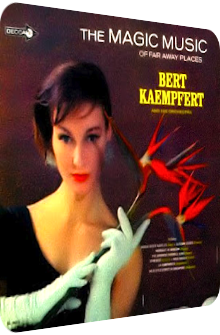
Bert Kaempfert
The Magic Music
Of Far Away Places
1965
The Magic Music Of Far Away Places is a travelog album by Bert Kaempfert (1923–1980) and one of his better offerings, although it is not as catchy and gleaming as his 70's works, of which I rate 1977’s Tropical Sunrise as the top pick due to its large amount of unique compositions and its many pompous climaxes. The Magic Music Of Far Away Places is still a good contender, as Kaempfert comes up with his own never-heard-before arrangements on this album as well.
Recorded back in Hamburg, six compositions were (co-)written by him, while the remaining six takes consist of both famous and less-known arrangements. While the brass sections are usually in the foreground and remain thus true to Kaempfert's way of producing albums in the 60's, a choir has also made the jump onto the album. Curiously enough, it's most often an all-male choir that sounds disinterested and bland. I'm usually critical about an overly melodramatic presentation, but this choir resides on the other side of the spectrum, humming along bored and quietly to the exotic material. If it isn't a male choir, it's an equally indifferent female version that is integrated all to quietly into the mix.
I'm probably overly critical, because the choirs aren't featured in each and every song, and since there are plenty of gems to be found: from sunny countries such as Italy and Brazil over Far Eastern territories of Japan and Malaysia to the final Polka (!) in Switzerland, Kaempfert presents a variety of colorful locations with a broader-than-usual focus; it's not just about the tropical glitz, but about perfectly normal or common music styles as well, depending on where you're coming from. As it is usual in his 60's work, Kaempfert plays it safe and presents a streamlined Easy Listening album. Since the styles vary so much, the surprise level is nonetheless high, with lots of stellar inclusions and quite ridiculous takes. Read on to see why the good outweighs the bad on this easily available release.
Italy is the point of departure, Moon Of Naples is the moment of wonder, Fox Trot is the particular style and Bert Kaempfert is the writer of this composition – for it is actually his most famous hit Spanish Eyes in disguise! Launching with saccharine strings, soon enough an acoustic guitar backing and a mixed choir merge. The latter hums gently along, and the added horns play the iconic fourteen-note theme in a glowing and sugar-sweet way. This version is on the brink of being pathetic and inherits one too many Latinisms of the original blueprint. The backing marimbas are nice enough, as is the paradisiac flute at the end. But apart from these devices, nothing is able to kindle my affection.
Speaking of kindling: Billy Kindle's and Peter DeRose's On A Little Street In Singapore, however, is presented by Kaempfert in a successful rendition. The Far Eastern marimbas and violin notes are immediately apparent, and the pompous brass bursts in the background are an interesting counterpart to the Asian flavor. The male choir is humming the same two notes time and again which makes this a rather funny inclusion. Funny in a good way, though. While Gerardo Matos Rodríguez' Argentinian Tango La Cumparsita is less-known in Exotica realms, Kaempfert delivers a hot-blooded take thanks to a bunch of quirky lead violas, hefty brass eruptions, the lamenting mixed choir in the background and revved up strings in the middle section, and the Latin feeling also remains in Kaempfert's own Mambossa that depicts a Brazilian Mambo via Latin percussion complete with wonderful guiros, two joyful brass melodies that are interacting with each other, exhilarative flutes and much reduced strings which make room for the remaining instruments to shine. Yes, this is a syrupy composition, but the swinging rhythm is really great, and the melodies are truly catchy. I'm hooked…
…and I remain in that state, for Freddy Morgan's and Hasegawa Yoshima's Japanese Farewell Song is the next interpretation on Kaempfert's agenda. Merging mallet and string instruments on the Far Eastern melody, the male choir and soft strings accentuate a singing geisha in the spotlight. Dark brass sections are integrated as well, but they're only heard for a short time. It's actually a great song if you can take the bold Japanese flavor that is less mystical rather than vivacious. The final song of side A is Monte Carlo, co-written by Bert Kaempfert and long-term collaborator and trumpeter Fred Moch. The beat is particularly swinging, and the pizzicato violins merge well with the horn hits and Moch's solo on the trumpet. The mixed choir parties in the background, while sunset-tinted strings glimmer in the distance. It's a proper big band song whose selling point is the uplifting rhythm. I'm not too fond of it, as its admittedly catchy melody isn't exotic enough in my opinion. If this song ws a bit slower and dreamier, it would have camouflaged its commonplace attitude and style a bit better. Anyway, it's catchy.
Side B launches with Hava Nagila, and since this song is usually performed by bands and artists to showcase how quick, hard and rapid they can play their signature instrument, Kaempfert's version is unusually majestic, but that's entirely welcome. Fred Moch plays the main melody yet again, while additional brass instruments answer him. The cymbals and shakers are mellow and fit perfectly in, without boosting the dynamic. Muffled knuckle sounds are interwoven, and the mixed choir sings solemnly in the background. It's a good version, if only for the fact that it's swinging in a graceful tempo.
After a short visit to the U.S.A. with Hoagy Carmichael's Star Dust that isn’t as good as Martin Denny’s take on his 1958 album Forbidden Island, but still manages to merge the most delicate strings with loads of horns, a silken trumpet and a boring performance by the choir on a slow beat, Autumn Leaves by Joseph Kosma and Johnny Mercer expands the instrument roster due to the prominent addition of a romantic mouth organ that is accompanied by liquid piano droplets. It is actually a surprisingly good arrangement, maybe overly melancholic, but that's the spirit of the original after all. Occasionally there are xylophone spirals interwoven as well, and the omission of the horn sections is refreshing. During the second part of this song, the strings become dreamier and underline the mouth organ with great style. The French feeling is well-presented, I don't have any complaints, for both the mood and the instrument-related setup are totally different from anything else on this album. Thumbs up!
The following Balkan Melody is the first of two co-productions by Bert Kaempfert with his longtime collaborator and band mate Herbert Rehbein on this release. It is yet again wonderfully varied due to the bold dependency on the accordion and the sunny acoustic guitars. The melodramatic evening setting is realized with a trumpet solo, and the following climactic concoction of this instrument and the accompanying strings is a tad kitschy, but does capture the assumed traditional music of the Balkan area.
While Kaempfert's take on Midnight In Moscow is based on the version of Kenny Bail and remains the only instance where the choir can be heard loud and clear in juxtaposition to dark trumpets and Sicilian jaw harps (despite the Muscovite allusion), the outro called Swissy Missy is the second Kaempfert/Rehbein joint-venture on the album and an Alpine Polka by the numbers with shedloads of accordions, eupeptic trumpets and saccharine strings. I'd love to slate this composition, but I can't and I won't. People from the Far East will love this gleeful ditty as much as the German community of Wisconsin does. This implied tradition of the Alps might be hard to swallow for the Germans, Austrians and Swiss, but the Far Eastern takes are probably equally alienating to the local residents in those affected countries. No big deal!
There's anything particularly wrong with The Magic Music Of Far Away Places. Especially during its final phase, the tonality and used instruments shift. While the release is brass-heavy, as it is typical for Kaempfert's releases of the 60's, the accordions, mouth organs and scattered mallet instruments are welcome devices that broaden the narrow setting quite a bit. It would have been nice if there were real Japanese instruments used on the respective tracks, but you can't have everything, and you can always count on Tak Shindo to fulfill these specific needs anyway. Four particularly successful songs can be distilled from this LP: Kaempfert's own Mambossa is sugar-sweet, but its swinging rhythm and the jocular brass melodies are catchy enough to make a lot of people succumb to them.
Then there's a slower, very majestic take on Hava Nagila that serves as a welcome counterpoint to the hundreds of hyper-hectic renditions out there. The third hit would be Autumn Leaves due to the French feeling that is painted by the mouth organ. I've already fallen in love with the French songs of Irv Cottler's travelog album Around The World In Percussion of 1961, so it's quite natural for me to adjust very quickly to the melancholy of Kaempfert's attempt. Finally, there's his Balkan Melody which is equally melodramatic, but its sunset-red Folk aura does work very well. It's no coincidence that three out of the four compositions are written or co-written by Kaempfert. He really knew how to sell sugary Easy Listening to the masses. The Tropics are missing from this release, there's no island featured except Japan. But this tour through wide parts of Europe, the Far East and Brazil is intriguing and varied enough to please those listeners who aren't too fond of the monotony of many a Nelson Riddle or Jackie Gleason album. It's one of Kaempfert's better albums.
My only complaint is the quiescence of the choirs. Only on Midnight In Moscow is the choir used to voluminous effect – at a time when most people are sleeping! In the end, a too quiet choir is probably better than a string of overly melodramatic performances. Alfred Newman's and Ken Darby's Ports Of Paradise (1960) is notoriously loved and hated in this regard. This little quibble shouldn't put you off anyway. The Magic Music Of Far Away Places is available on LP, CD and digital download. Watch out for the remastered CD which contains five bonus tracks that were created around the time of the release but didn't make it to the final version due to vinyl-related time restrictions. Among them is the gem Tales From The Vienna Woods – it's no jungle, but hey, Exotica is also about the yearning in the end, not just about the Tropics.
Ambient Review 114: Bert Kaempfert – The Magic Music Of Far Away Places (1965). Originally published on Sep. 1, 2012 at AmbientExotica.com.
